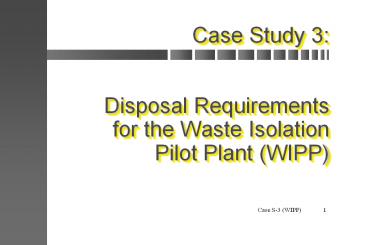Case Study 3: Disposal Requirements for the Waste Isolation Pilot Plant (WIPP) - PowerPoint PPT Presentation
1 / 18
Title:
Case Study 3: Disposal Requirements for the Waste Isolation Pilot Plant (WIPP)
Description:
Demonstrating regulatory compliance for a transuranic (TRU) waste repository. Case S-3 (WIPP) ... Transuranic radioisotopes. RCRA-listed or -identified ... – PowerPoint PPT presentation
Number of Views:53
Avg rating:3.0/5.0
Title: Case Study 3: Disposal Requirements for the Waste Isolation Pilot Plant (WIPP)
1
Case Study 3 Disposal Requirements for the
Waste Isolation Pilot Plant (WIPP)
2
Meeting the RCRA Challenge
- RCRA is one of the principal regulatory statutes
of concern to EM managers because it regulates
the mixed waste found at many facilities . . .
its dual regulation by the Resource Conservation
and Recovery Act (RCRA) and the Atomic Energy Act
cause some challenges in its management.
3
Meeting the RCRA Challenge
- Land disposal restrictions (LDRs) require waste
to be treated to certain standards before
disposal - Treatment capacity for mixed waste is limited
4
Meeting the RCRA Challenge
- Considerable difficulties occur in the attempt to
implement RCRA at EM sites - According to RCRA standards, considerable amounts
of mixed waste cannot be - Treated
- Stored, or
- Disposed of
5
EM Guiding Principles
- Safety First
- Risk Reduction
- Scientific Orientation
- Management Accountability
- Decision Transparency
- Stewardship
6
Case Study Introduction
- Disposal Requirements for the Waste Isolation
Pilot Plant (WIPP) explores - Applying for the first No-Migration Variance
(NMV) ever submitted in the history of the
Environmental Protection Agency (EPA) - Demonstrating regulatory compliance for a
transuranic (TRU) waste repository
7
The WIPP
- The WIPP is an underground geologic repository
for the permanent disposal of TRU waste.
8
WIPP Facility
9
The WIPP
- In 1984, Congress enacted the Hazardous and Solid
Waste Amendments prohibiting land disposal of
hazardous waste unless - Waste is treated to meetEPA requirements
- The EPA determinesthat the LDRs arenot
applicable
10
The WIPP
- For the EPA to determine that the LDRs are not
applicable, it must be demonstrated to a
reasonable degree of certainty that there will
be no migration of hazardous constituents from
the disposal unit for as long the waste remains
hazardous.
11
The WIPP
- Under the NMV, the EPA must consider
- Long-term land disposal
- Management of the hazardous waste
- Persistence, toxicity, mobility, and
bioaccumulative potential of the waste
12
RH-TRU CH-TRU Disposal Room in WIPP
13
The WIPP
- A NMV was required because the wastes shipped to
the facility will be radioactive mixed wastes
that contain - Transuranic radioisotopes
- RCRA-listed or -identifiedchemical constituents
14
The WIPP
- On November 14, 1990, the EPAs NMD concluded . .
. that the DOE had demonstrated . . . that
hazardous constituents will not migrate from the
WIPP disposal unit during the Test Phase . . . .
15
WIPP and New Mexico Regulations
- In 1996, DOE submitted a RCRA Part B Permit to
the State of New Mexico - In 1998, New Mexico issued a revised Draft RCRA
Part B permit
16
WIPP and the NMV
- In 1993, DOEs approach for the test phase
changed and the NMV issued by EPA in 1990 became
immaterial - In June 1996, DOE submitted a new NMV to EPA
- In September 1996, Congress amended the WIPP Land
Withdrawal Act deleting the need for NMV
17
The WIPP
- This case study illustrates the regulatory
process for WIPP, which culminated in the first
shipment of waste to the site on March 26, 1999
18
Review Question
- WIPP did not have to obtain a No Migration
Variance to begin operation because - a. The No Migration Determination received from
EPA for the test phase also addressed the
operation of the facility. - b. Congress removed the requirement to obtain a
No Migration Determination in the FY 1997
Defense Authorization Bill. - c. As a deep geologic repository, WIPP is not
considered land disposal, and
therefore RCRA does not apply.

